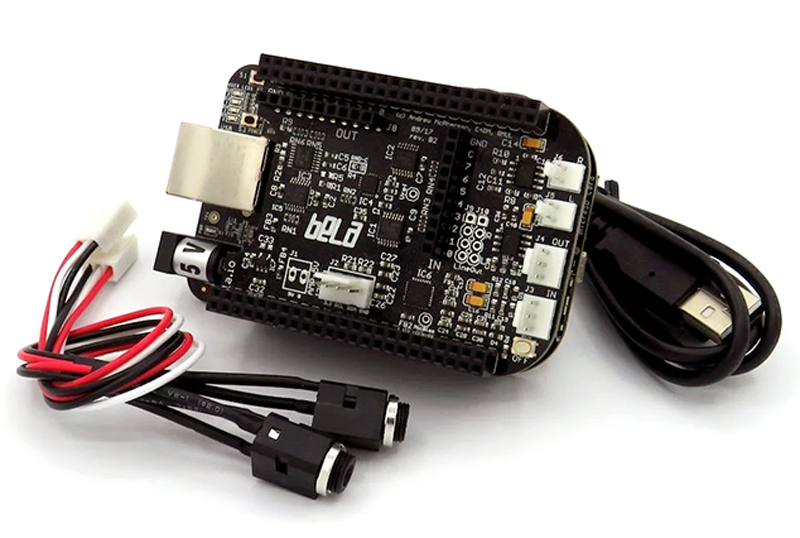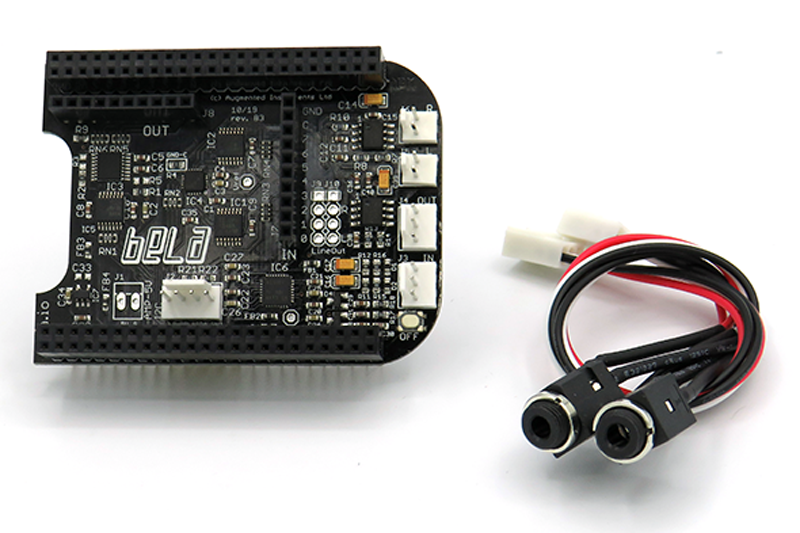Bela
The board that started it all

Bela was born out of musical instrument research. Since debuting in 2016 Bela has been used in thousands of projects. It was designed specifically for creating new musical instruments, effects boxes, and sound devices but its use has expanded to include kinetic sculpture, interactive art, e-textiles, digital crafts and creative electronics projects of all kinds.
Table of contents
Bela tech specs
Bela has the following hardware features:
- 8 16-bit analog inputs
- 8 16-bit analog outputs
- 16 digital I/O
- 2 audio input channels
- 2 audio output channels
- On-board speaker amplifiers
- 4GB on-board eMMC (flashable internal memory)
- Balanced audio lineout
An assembled Bela system (Bela cape + BeagleBone Black) has dimensions of 87mm x 54mm, and is 27mm in height.
Bela Starter Kit

The Bela Starter Kit includes everything you need to get started. It includes:
- Assembled Bela unit (Bela cape + BeagleBone Black)
- 2 x audio adapters
- USB cable
- Comes with the latest Bela software pre-flashed to internal memory
Bela cape

Bela is also available as a standalone cape. It comes with 2 audio adapters, but does not include the BeagleBone Black or USB cable, and you must flash a micro SD card with the Bela software yourself.
Developing Bela
The story beings in 2014. Andrew McPherson and Victor Zappi were developing a music research study in the Centre for Digital Music at Queen Mary University of London, and needed to make an instrument. In building this instrument they required two things: a system that could process sensor data and audio that could be fully embedded (in other words, that it didn’t need to be attached to a laptop to produce sound), and a system with very low latency and jitter for so the interaction would feel natural and immediate for musicians . Together they developed a system to build the D-Box.
The system that went on to become Bela was based on the open-source computer BeagleBone Black, and was known as BeagleRT (short for BeagleBone Real Time). Andrew’s research group, the Augmented Instruments Lab used to create many new musical instruments and in interaction experiments, and Andrew taught a course on real-time digital signal processing with it at Queen Mary University of London. In 2016 a spin out company from the lab, Augmented Instrument Ltd, decided to further develop BeagleRT into a commercial product renamed Bela, and launched it on Kickstarter.
Compatible products
Over time we have developed accessories for Bela, and have collaborated with others to build extensions as well. These include:
- The Audio Expander, an add-on capelet that turns Bela’s analog I/O into more audio channels
- The Multiplexer, an add-on capelet that expands the 8 analog I/O into a massive 64
- PEPPER, a bare PCB kit for developing a programmable module for snyth experimentation
- Trill, a family of capacitive touch sensors compatible with Bela as well as most microcontrollers
Some products developed through collaboration with others:
- The CTAG series (developed in conjunction wtih XXX), a Bela-compatible system for multi-channel audio
- SALT and SALT+ (developed in collaboration with Rebel Tech), a fully assembled and programmable synth module
